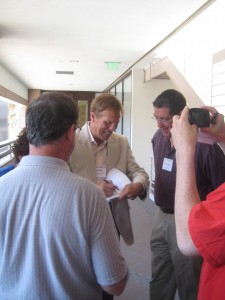Wes Parker was a six-time Gold Glove first baseman for the Los Angeles Dodgers. The Southern California native was a defensive specialist, named as one of the 50 Greatest Gold Glove players of all time by Rawlings.
Parker played from 1964 – 1972, well before the stain of steroids had made its mark on the game of baseball. I had a chance to ask Wes Parker about steroids, at the recent SABR (Society for American Baseball Research) convention in Long Beach.
Parker pulled no punches in speaking out against steroids – and naming names, starting with former Giants slugger Barry Bonds.
“I will tell you this,” Parker exclaimed to two dozen SABR members huddled around him. “When Barry Bonds was on a roll, when he was hitting all those home runs and hitting for average – he’s the best hitter I’ve ever seen in my life!!”
“I talked to Cepeda about it he said the same thing,” Parker noted. “I talked to McCovey about it. He said, ‘Barry Bonds was the best hitter ever – during that stretch.’”
I didn’t know steroids could make a hitter that good,” Parker explained. “But here’s how you could tell: it wasn’t just the home runs, it was the patience – remember all the walks he (Bonds) was getting? He was getting 150 walks and still hitting 65 – 70 home runs.”
Parker was intent on making his point: “If you watched him take a pitch – most hitters when they take a pitch there’s a little confusion because the ball’s coming so fast. So you start to swing and you stop. Or you jump back a little bit. You do something to indicate that you’re still undecided. It was as if Barry Bonds knew the pitch was going to be a strike or a ball after the ball emerged from the pitcher’s hand three feet. He’d be standing here, he’d just take a pitch, he’s just go BOOM – like that. It was like he read the pitch the moment it came out of the pitcher’s hand. You can’t do that – unless you’re taking steroids.”
“Steroids enhance your reactions that much,” Parker continued.” I’ve never taken them. But I’ve talked to guys who have taken steroids and they said, ‘Wes you can’t believe it. You can’t believe what they do for you.'”
How did players hide their steroid use?
“They were able to stay ahead of the test, ” Parker opined. “That’s the thing – the Commissioner couldn’t come up with a test that was foolproof and would catch these guys. That’s the problem with Selig is that he’s reactive, not proactive,” Parker stated.
But taking steroids in that era was not against the rules. So I asked Parker, “Why not induct Barry Bonds into the Hall of Fame since it was not illegal?”
He answered, “He was a great player before he started taking steroids – way before his head grew and his feet grew. So you could make that case. And he is as good a ballplayer as you’re very going to see. He really is, he’s that good. But he still did something that he shouldn’t have done. And it was illegal.”
But a few SABR members argued that Bonds – and other players tainted by the scandal of steroids – were not breaking any laws.
So Parker asked the group, “Okay I got a question for everyone here, do you think these steroid guys, the guys I mentioned – Palmeiro, Mark McGwire, Sosa, Bonds – should they be in the Hall of Fame?
Almost everyone said no.
Parker added,“I don’t think so either.”
So what’s next up for Wes Parker? He told the crowd hes working on a book project about his childhood and his days with the Dodgers. His book, he said, would also focus on some of the players he competed against – “especially Clemente.”
“ If I could wish anything it would be that all of you had gotten a chance to see Roberto Clemente play a lot, ” he told the group.
“In 1966 we played the Pirates. And Saturday night Clemente went 5 for 6 and Sunday afternoon he went 5 for 5. He went 10 for 11 in less than a 24 hour period. And the only better hitting exhibition I saw in my career was – listen to this, talk about great hitting – we played a double header against St. Louis in 1964 in Dodger stadium. It was a day time doubleheader. Koufax pitched the first game, Drysdale the second . Curt Flood went 4 for 4 against both of them. 8 for 8 against Drysdale and Koufax in a doubleheader! I’m getting goosebumps,” he stated as the crowd cheered.
“Ever hear of an athlete getting into the zone?” he asked the group.
“It only happened to me one time, ” he stated. “In Houston I went 3 for 4, 1 for 4, 3 for 4, then 4 for 4 and 3 for 5. And I got 8 hits in a row. (Later) I lined out into a double play against San Diego, then doubled and tripled,” he stated.
“I should have had 11 in a row and the record was 10. And I got into the zone, it’s the most incredible feeling – where you don’t have to make an effort any more. It’s like you’re channeling into energy from up above and something is working through you. God what a feeling!”
What was going through Parker’s mind when he was in that zone?
“I was thinking I can’t believe they’re paying me for playing this game – for getting all these hits. You’re a little outside of yourself. It’s like watching yourself and everything slows down.”
There is no slow down for Baseball Between Us. Coming up in my next blog: a visit to Raley Field – and a feature story about the Sacramento River Cats! Stay tuned.

